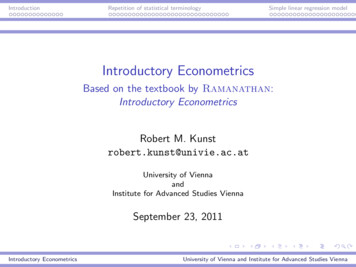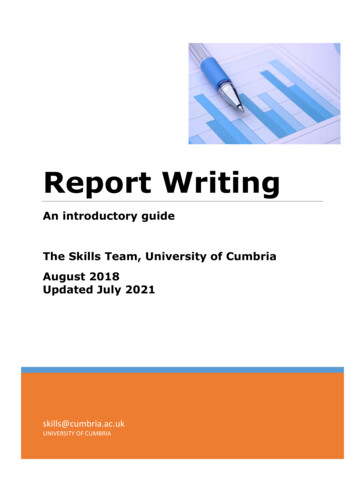
Transcription
An introductory guide to the medical device regulation (MDR)and the in vitro diagnostic medical device regulation ssessmentPlacing adevice on themarketUDI and EudamedSupply chainobligationsPMS and vigilanceContact
Introduction - How to use this guideNavigate through the topics listed along the bottom of each page using thebuttons on either side of the document.You can use the arrow buttons to navigate through the pages one by one(you can also do this by using the left and right cursor buttons on yourkeyboard) or to jump to the first and last pages of the document (alsocontrolled with the ‘Home’ and ‘End’ buttons on your keyboard).Any words in Green can be clicked on to take you to the relevant externalresource.For best results, please view this document in “full screen” mode (Ctrl yassessmentPlacing adevice on themarketUDI and EudamedSupply chainobligationsPMS and vigilanceContact
Introduction2017201820192020202120223 year transition periodEU MDRimplementationEU MDRFormalpublication5 year transition periodEU IVDRFormalpublicationEU IVDRimplementationThese Regulations entered into force on 25th May 2017.However, most requirements will not fully apply until 26thMay 2020 for Medical Devices, and 26th May 2022 for InVitro Diagnostic Medical ormityassessmentPlacing adevice on themarketUDI and EudamedSupply chainobligationsPMS and vigilanceContact
Definitions - Medical DeviceMedical DeviceExamples: dental and surgical instruments bandages and splints treatment chairs and hospital bedsDefinition*:‘Medical device’ means any instrument, apparatus, appliance,software, implant, reagent, material or other article intended bythe manufacturer to be used, alone or in combination, for humanbeings.*A full definition can be found in Article 2(1) of the tyassessmentPlacing adevice on themarketUDI and EudamedSupply chainobligationsPMS and vigilanceContact
Definitions - In Vitro Diagnostic Medical DeviceIn Vitro Diagnostic Medical DeviceExamples: pregnancy tests blood glucose monitorsDefinition*:‘In vitro diagnostic medical device’ means any medical device which isa reagent, reagent product, calibrator, control material, kit, instrument,apparatus, piece of equipment, software or system, whether usedalone or in combination, intended by the manufacturer to be used invitro for the examination of specimens, including blood and tissuedonations, derived from the human body.*A full definition can be found in Article 2(2) of the tyassessmentPlacing adevice on themarketUDI and EudamedSupply chainobligationsPMS and vigilanceContact
Definitions - Borderline ProductsBorderline ProductsExamples: Medicated surgical dressings (medical device or medicinal productdepending on manufacturer’s claim) Head lice products (medical device or medicinal product dependingon their mode of action)Some products are hard to distinguish from a medicine or a medicaldevice. These products are called borderline products until their statushas been decided.MHRA determines whether a product falls within the definition of amedicine – ‘medicinal product’ – or a medical device and providesinformation on whether a product is a medicine or a medical device ornot.For more information, please visit our rmityassessmentPlacing adevice on themarketUDI and EudamedSupply chainobligationsPMS and vigilanceContact
Definitions - Aesthetic ProductsAesthetic ProductsExamples: Non-corrective contact lenses Equipment for liposuction Equipment intended for brain stimulationDefinition:Annex XVI of the MDR lists out groups of products without an intendedmedical purpose, which will now be regulated as medical devicesManufacturers of products listed in Annex XVI of the MDR shall complywith the relevant common specifications* for those products.*These common specifications are expected to be published by theCommission by 26th May tyassessmentPlacing adevice on themarketUDI and EudamedSupply chainobligationsPMS and vigilanceContact
ClassificationClassification is based on risk, as set out in Annex VIII of the MDR andAnnex VII of the IVDR.Manufacturers need to demonstrate that their medical device meets therequirements in the MRD or IVDR by carrying out a conformity assessment.The assessment route depends on the classification of the device.The risk class determines whether or not a conformity assessment wouldbe required (which is done by a Notified mityassessmentPlacing adevice on themarketUDI and EudamedSupply chainobligationsPMS and vigilanceContact
ClassificationMedical DevicesIncreasing riskHigh riskExamples:PacemakersHeart valvesImplanted cerebralsimulatorsNotified Bodyapproval requiredExamples:CondomsLung ventilatorsBone fixation plateExamples:Dental fillingsSurgical clampsTracheotomy esSpectaclesIn Vitro DiagnosticMedical DevicesClass IIIClass DClass IIbClass IIaClass ILow riskClass I medical deviceswill require involvementof a Notified Body ifthey are sterile, have ameasuring function orare re-usablesurgical instruments.Examples:Hepatitis B blood-donorscreeningHIV blood diagnostic test,;ABO blood groupingClass CExamples:Blood glucose self-testingPSA screening;HLA typingClass BExamples:Pregnancy self-testingUrine test stripsCholesterol self-testingClass AExamples:Clinical chemistry analysersSpecimen receptacles;Prepared selective ConformityassessmentPlacing adevice on themarketUDI and EudamedSupply chainobligationsPMS and vigilanceContact
Classification - Conformity assessmentConformity assessmentManufacturers need to demonstrate that the medical device meets the requirements in theMDR or IVDR by carrying out a conformity assessment. The assessment route dependson the classification of the device.Manufacturers can place a CE mark on the product to show that the medical device hasmet the requirements when it has passed the conformity ConformityassessmentPlacing adevice on themarketUDI and EudamedSupply chainobligationsPMS and vigilanceContact
Classification - Conformity assessmentMedical DevicesIn Vitro DiagnosticMedical DevicesHigh riskIncreasing riskClass IIINotified Bodyapproval requiredClass DWhich classes of productsrequire conformity assessmentby a notified body?Approval is required for Class IIa, IIb andIII medical devices and Class B, C and D invitro diagnostic devices.Class IIbClass CClass IIaClass BSome Class I and Class A devices willrequire notified body approval for parts ofthe manufacturing process that relates tosterility or metrology, if the medical deviceincludes sterile products or a measuringfunction.Manufacturers can certify their productswith any notified body within the EU.Self-assessmentClass IClass ALow ityassessmentPlacing adevice on themarketUDI and EudamedSupply chainobligationsPMS and vigilanceContact
Classification - Notified BodyMedical DevicesIn Vitro DiagnosticMedical DevicesIncreasing riskHigh riskNotified Bodyapproval requiredClass IIIClass DClass IIbClass CNotified BodyNotified bodies are independent certificationbodies designated by national CompetentAuthority (i.e. MHRA). They perform thirdparty conformity assessment activitiesincluding calibration, testing, certificationand inspection.A list of active notified bodies can be foundon NANDO.Self-assessmentClass IIaClass BClass IClass ALow ityassessmentPlacing adevice on themarketUDI and EudamedSupply chainobligationsPMS and vigilanceContact
Conformity assessmentWhat requirements do I need to meet for a conformity assessment?1. General Safety and Performance Requirements (Annex I of the MDR and IVDR): Benefits must outweigh risks and achieve the claimed performance - This must beproven with supporting clinical evidence and investigation Chemical, physical and biological properties for medical devices Performance characteristics for in vitro diagnostic medical devices Information supplied by the manufacturer with the device - For example, instructions foruse. It is important that devices are labelled correctly2. Technical documentation (Annex II of the MDR and IVDR)3. Harmonised standards / common specifications (Articles 8 and 9 of the MDR and IVDR)Please see Annex IX, X and XI of the MDR and the IVDR for more nConformityassessmentPlacing adevice on themarketUDI and EudamedSupply chainobligationsPMS and vigilanceContact
Conformity assessmentIn what instances can I place a device on the market withoutundertaking an assessment of conformity?In certain circumstances, a Competent Authority may authorise the placing on the marketor putting into service a specific device that has not carried out the procedures referred toin Article 52 of the MDR or Article 48 of the IVDR.This can happen in circumstances that are in the interest of public health or patient safetyor health.See Article 59 of the MDR and Article 54 of the IVDR for more information on when youcan derogate from the conformity assessment ConformityassessmentPlacing adevice on themarketUDI and EudamedSupply chainobligationsPMS and vigilanceContact
Placing a device on the marketPassFail1. Pass a conformity assessmentThis does not apply to most Class I medical devices and Class A in vitro diagnostic devices2. Draw up a declaration of conformity (Annex IV of the MDR and IVDR)3. Place a CE mark on the deviceCE marks are not unique to medical devices4. Assign a Basic UDI-DI and provide it to the UDI databaseFor devices other than custom-made devices5. Submit key information about the manufacturer, and authorisedrepresentative and importer if applicable, to the electronic system (Eudamed)For devices other than custom-made devices6. Place your CE marked device anywhere in Europe or put yourdevice into ormityassessmentPlacing adevice on themarketUDI and EudamedSupply chainobligationsPMS and vigilanceContact
UDI and EudamedThe UDI system provides a consistent and standard way to identify medical devices throughout theirdistribution and use by health care providers and patients. Most devices will be required to have a UDIon their label and packaging, and for certain devices, on the product itself.‘Unique Device Identifier’ (‘UDI’) is a series of numbers that enables for the tracing of the manufacturer,device (UDI-DI number) and the unit of device production (UDI-PI number).UDIs will be phased in over several years, starting with the highest risk devices, such as heart valvesand pacemakers.See Article 27 of the MDR and Article 24 of the IVDR for more nConformityassessmentPlacing adevice on themarketUDI and EudamedSupply chainobligationsPMS and vigilanceContact
UDI and EudamedThe European databank on medical devices (Eudamed), is a database that those who manufactureand supply medical devices, as well as Notified Bodies, health institutions and Competent Authorities,will have access to.Using this system, those involved in manufacturing and supplying medical devices and IVDs willneed to register their organisation and devices, upload relevant documentation, apply for clinicalinvestigations and performance studies, and upload post-market surveillance documentation.Eudamed is currently being overhauled for the new regulations to increase capabilities and allow wideraccess.See Article 30* of the MDR and Article 27* of the IVDR for more information.*These requirements will not apply if the necessary improvements to the Eudameddatabase are not completed on mityassessmentPlacing adevice on themarketUDI and EudamedSupply chainobligationsPMS and vigilanceContact
Supply chain obligations“I’m an importer”“I’m a manufacturer”“I’m a distributor”“I’m an nsClassificationConformityassessmentPlacing adevice on themarketUDI and EudamedSupply chainobligationsPMS and vigilanceContact
Supply chain obligations - ’ means a natural or legal person who manufactures or fullyrefurbishes a device or has a device designed, manufactured or fully refurbished,and markets that device under its name or trademark.Obligations:Manufacturers will have a number of additional obligations, including: Having at least one person responsible for regulatory compliance; Ensuring that sufficient financial coverage is in place; Ensuring that quality management systems meet the more stringentrequirements.For more details, see Article 10 of the MDR and the mityassessmentPlacing adevice on themarketUDI and EudamedSupply chainobligationsPMS and vigilanceContact
Supply chain obligations - Authorised representativeAuthorised representativeDefinition:‘Authorised representative’ means any natural or legal person established withinthe Union who has received and accepted a written mandate from a manufacturer,located outside the Union, to act on the manufacturer’s behalf in relation to specifiedtasks with regard to the latter’s obligations under this Regulation.Obligations:Authorised representatives will have a number of additional obligations, including: Having at least one person responsible for regulatory compliance; Where the manufacturer is not established in a Member State and has notcomplied its obligations, the authorised representative shall be legally liablefor defective devices on the same basis as, and jointly and severally with, themanufacturer, and will need to ensure that sufficient financial coverage is in place.For more details, see Article 11 of the MDR and Article 12 of the the mityassessmentPlacing adevice on themarketUDI and EudamedSupply chainobligationsPMS and vigilanceContact
Supply chain obligations - ImporterImporterDefinition:‘Importer’ means any natural or legal person established within the Union that placesa device from a third country on the Union market.Obligations:Importers will have a number of additional obligations, including verifying that: The device has been CE marked; The manufacturer is identified and it has an authorised representative, if required; The device has been labelled correctly and a UDI has been assigned to thedevice; The device is registered in the electronic system (Eudamed).For more details, see Article 13 of the MDR and the mityassessmentPlacing adevice on themarketUDI and EudamedSupply chainobligationsPMS and vigilanceContact
Supply chain obligations - DistributorDistributorDefinition:‘Distributor’ means any natural or legal person in the supply chain, other than themanufacturer or the importer, that makes a device available on the market, up untilthe point of putting into service.Obligations:Distributors will have a number of additional obligations, including verifying that: The device has been CE marked; The device is accompanied relevant information to be supplied by themanufacturer; The importer has complied with their general obligations; A UDI has been assigned to the device.For more details, see Article 14 of the MDR and the IVDR.Devices can also be offered by means of information society services. Theobligations on these distributors are at Article 6 of the MDR and the mityassessmentPlacing adevice on themarketUDI and EudamedSupply chainobligationsPMS and vigilanceContact
PMS and vigilance - Post-market surveillance requirementsPost-market surveillance requirements (preventative / proactive)Definition:‘Post-market surveillance’ means all activities carried out by manufacturers incooperation with other economic operators to institute and keep up to date asystematic procedure to proactively collect and review experience gained from devicesthey place on the market, make available on the market or put into service for thepurpose of identifying any need to immediately apply any necessary corrective orpreventive actions.Key obligations: Ensure ongoing safety of device – appropriate/risk benefit balance Inform development of future iterations of the device Conduct FSCAs (field safety corrective actions)Field safety corrective actions are corrective actions taken by a manufacturer fortechnical or medical reasons to prevent or reduce the risk of a serious incident inrelation to a device made available on the ormityassessmentPlacing adevice on themarketUDI and EudamedSupply chainobligationsPMS and vigilanceContact
PMS and vigilance - Post-market surveillance requirementsPost-market surveillance requirements (preventative / proactive)New features of the Regulations: PSURs - Periodic Safety Summary Report: Summarises the results and conclusionsof the analyses of the post-market surveillance data. See Article 86 of the MDR andArticle 81 of the IVDR PMCF / PMPF - Post-Market Clinical / Performance Follow-Up: A continuous processthat updates the clinical / performance evaluation. See Annex XIV, Part B of the MDRand Annex XIII, Part B of the IVDR Other post-market studiesSee Chapter VII, Section 1 of the MDR and IVDR for more nConformityassessmentPlacing adevice on themarketUDI and EudamedSupply chainobligationsPMS and vigilanceContact
PMS and vigilance - Vigilance requirements (reactive)Vigilance requirements (reactive)Key obligations: Reporting of serious incidents Voluntary and mandatory reporting Trend reportingSee Chapter VII, Section 2 of the MDR and IVDR for more information.Serious incidentsA serious incident means any incident that directly or indirectly led, might have led ormight lead to any of the following: the death of a patient, user or other person the temporary or permanent serious deterioration of a patient’s, user’s or otherperson’s state of health a serious public health rmityassessmentPlacing adevice on themarketUDI and EudamedSupply chainobligationsPMS and vigilanceContact
PMS and vigilance - Market surveillanceMarket surveillanceDefinition:‘Market surveillance’ means the activities carried out and measures taken bycompetent authorities to check and ensure that devices comply with the requirementsset out in the relevant Union harmonisation legislation and do not endanger health,safety or any other aspect of public interest protection.See Chapter VII, Section 3 of the MDR and IVDR for more nConformityassessmentPlacing adevice on themarketUDI and EudamedSupply chainobligationsPMS and vigilanceContact
Contact ssmentPlacing adevice on themarketUDI and EudamedSupply chainobligationsPMS and vigilanceContact
Eudamed is currently being overhauled for the new regulations to increase capabilities and allow wider access. See Article 30* of the MDR and Article 27* of the IVDR for more information. *These requirements will not apply if the necessary improvements to the Eudamed database are not completed on time.










